Potrebujeme váš súhlas na využitie jednotlivých dát, aby sa vám okrem iného mohli ukazovať informácie týkajúce sa vašich záujmov. Súhlas udelíte kliknutím na tlačidlo „OK“.
ASTM D7339-12
Standard Test Method for Determination of Volatile Organic Compounds Emitted from Carpet using a Specific Sorbent Tube and Thermal Desorption / Gas Chromatography
Automaticky preložený názov:
Štandardná skúšobná metóda pre stanovenie prchavých organických látok emitovaných z kobercov pomocou špecifickej sorbent Tube a termické desorpcia / plynovej chromatografie
NORMA vydaná dňa 15.10.2012
Informácie o norme:
Označenie normy: ASTM D7339-12
Poznámka: NEPLATNÁ
Dátum vydania normy: 15.10.2012
Kód tovaru: NS-38224
Počet strán: 10
Približná hmotnosť: 30 g (0.07 libier)
Krajina: Americká technická norma
Kategória: Technické normy ASTM
Kategórie - podobné normy:
Anotácia textu normy ASTM D7339-12 :
Keywords:
carpet, chamber, emission, gas chromatography, indoor air, mass spectrometry, thermal desorption, VOC, volatile organic compounds, ICS Number Code 97.150 (Floor coverings)
Doplňujúce informácie
| Significance and Use | ||||||||||||||||||||
|
5.1 Manufacturers of carpet need to monitor emissions of VOCs to assess the environmental impact of their products indoors. These results are also used to demonstrate compliance with VOC emission limits for individual VOCs. 5.2 These data are also used to understand which VOCs are emitted from a product or material and to measure the magnitude of those emissions. 5.3 Emission data may be used to compare different lots of carpet of the same materials of construction, or carpets composed of different materials of construction, in order to develop products with lower emissions and lower potential environmental impact. 5.4 This test method should be used in conjunction with practices/guidelines for emissions testing such as Guide D5116, Practice D7143, Practice D7706, ISO 16000-9, and ISO 16000-10. These detail how to select and prepare samples and how and when to carry out emissions tests such that the concentration and profile of vapors in the exhaust air of the emission chamber/cell are representative of the product under test. This standard method covers the sampling and analysis of volatile organic compounds in the exhaust gas from the chamber/cell using thermal desorption—compatible sorbent tubes and will provide the necessary analytical consistency to ensure that reproducible data is obtained for the analysis of identical vapor samples by different laboratories. |
||||||||||||||||||||
| 1. Scope | ||||||||||||||||||||
|
1.1 This test method describes an analytical procedure for identifying and quantifying the masses of individual volatile organic compounds (individual VOCs or IVOCs) that are emitted into a flow of air from carpet specimens and collected on sorbent sampling tubes during emissions testing. 1.2 This test method will be used in conjunction with a standard practice for sampling and preparing carpet specimens for emissions testing. If a specific chamber practice is not available for the carpet specimens, this standard test method should be used in conjunction with approved standard practices for emissions testing and sample preparation. 1.3 When used in conjunction with standard practices for carpet specimen preparation and collection of vapor-phase emissions , this test method will provide a standardized means of determining the levels of IVOC in the exhaust stream of the emissions test chamber/cell. If this test method is used with a reliable practice for emissions testing, these IVOC levels can be used to determine the emission rate from a unit quantity (usually surface area) of the sample material under test. 1.4 VOCs in the exhaust stream of an emissions test device are collected on thermal desorption tubes packed with a specific combination of sorbents using active (pumped) sampling. (See Practice D6196 for a more general description of vapor collection using pumped sampling onto sorbent tubes). The samples are analyzed by thermal desorption (TD) with gas chromatography and mass spectrometry detection (GC/MS) and/or flame ionization detection (FID) depending upon the requirements of the specific materials emissions testing/certification protocol. 1.5 This test method can be used for the measurement of most GC-compatible organic vapors ranging from the approximate volatility from n-hexane to n-hexadecane (that is, compounds with vapor pressures ranging from 16 kPa to 4 × 10-4 kPa at 25°C). Properties other than a compound’s vapor pressure such as affinity for the sorbent may need to be taken into account. Compounds with vapor pressures outside this range may or may not be quantifiable by this method. However, qualitative data concerning the identity of a compound(s), outside the stated volatility range for quantitation, may still be useful to the user. The method can be applied to analytes over a wide concentration range—typically 1 μg/m3 to 1 mg/m3 concentration of vapor in the exhaust air from the emission cell or chamber. 1.6 This test method is not capable of quantifying all compounds which are emitted from carpets. See the appropriate test practices/methods for determining other compounds that are not amenable to analysis by gas chromatography (that is, Test Method D5197 for the determination of aldehydes). 1.7 Units—The values stated in SI units are to be regarded as standard. No other units of measurement are included in this standard. 1.8 This standard does not purport to address all of the safety concerns, if any, associated with its use. It is the responsibility of the user of this standard to establish appropriate safety and health practices and determine the applicability of regulatory limitations prior to use. |
||||||||||||||||||||
| 2. Referenced Documents | ||||||||||||||||||||
|
Podobné normy:
Historická
1.8.2012
Historická
1.7.2012
Historická
1.10.2011
Historická
15.4.2013
Historická
1.7.2012
Historická
1.3.2009


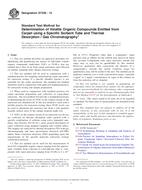
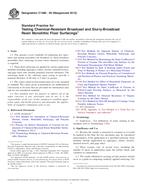 ASTM C1486-00(2012)..
ASTM C1486-00(2012)..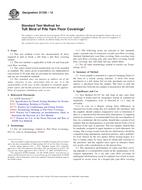 ASTM D1335-12
ASTM D1335-12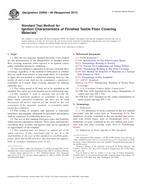 ASTM D2859-06(2011)..
ASTM D2859-06(2011)..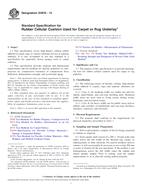 ASTM D3676-13
ASTM D3676-13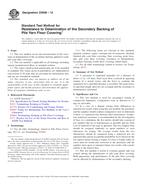 ASTM D3936-12
ASTM D3936-12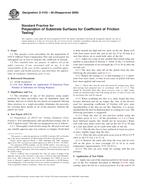 ASTM D4103-90(2009)..
ASTM D4103-90(2009)..
 Cookies
Cookies
